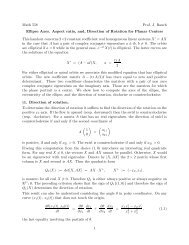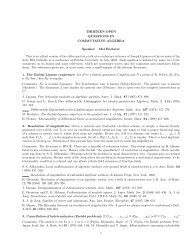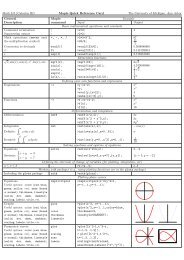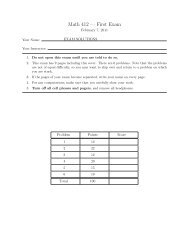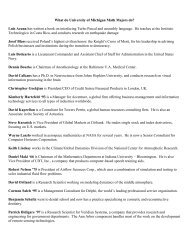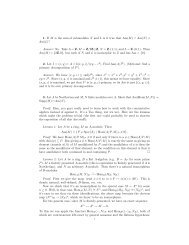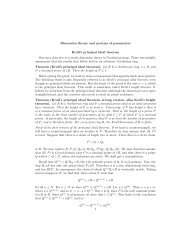Fronts Propagating with Curvature- Dependent Speed: Algorithms ...
Fronts Propagating with Curvature- Dependent Speed: Algorithms ...
Fronts Propagating with Curvature- Dependent Speed: Algorithms ...
Create successful ePaper yourself
Turn your PDF publications into a flip-book with our unique Google optimized e-Paper software.
ALGORITHMS FOR SURFACE MOTION PROBLEMS 21<br />
Thus, PSC algorithms, or propagation of surfaces under curvature algorithms, rely<br />
on approximaton of<br />
<strong>with</strong> W = $,,, . . . . ti,., where we have written the equations for the case F(K) = 1<br />
for simplicity. In Formulation (1 ),<br />
whereas in Formulation (2),<br />
H(u 1, . ..> u,)= -(l+u:+ ... +u2,p2, (3.2)<br />
H(u,, . . . . u,)= -g+ . . . + gJ’/2. (3.3)<br />
While Formulation (2) is more general, formulation (1) requires one less dimen-<br />
sion, and thus is less time-consuming from the point of view of numerical com-<br />
putations. In this section, we describe numerical methods that can be used to<br />
approximate the solution to Eq. (3.1). First, we describe first-order monotone<br />
methods for one dimension, followed by higher order models. Then we present<br />
algorithms for first-order monotone methods for several dimensions, foilowed<br />
higher order schemes. We then show how these schemes can be used to solve the<br />
general case of speed function F(K). Initialization and boundary conditions are then<br />
discussed, followed by the extension of the algorithm to propagation plus passive<br />
advection.<br />
A. One Space Dimension<br />
(1) First-Order Schemes for One Space Dimension<br />
In one space dimension, the technology for single conservation laws goes over<br />
almost directly. We differentiate Eq. (3.1) <strong>with</strong> respect to the single space variable x<br />
and let u = $X to produce<br />
u, + [H(u)]~ = 0. (3.~1<br />
An algorithm to approximate the solution to the above is said to be in c~~ser~ut~~~<br />
form (that is, conserves U) if it can be written in the form<br />
u” + 1 = uj” - At/Ax( gj”, 1,2 - gi”- &.<br />
I<br />
Here, the numerical flux function gj+ 1,2 = g(uj- p+ i, . . . . uj+ q+ 1) must be Lipschitz<br />
and satisfy the consistency requirement g(u, . . . . U) = H(u). From here on, let $( ul)<br />
be the exact (approximate) solution to Eq. 3.1.<br />
A scheme is called monotone if the right-hand side of Eq. (3.5) is a non-decreasing<br />
(3*5)



